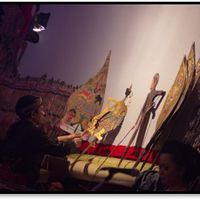Javanese puppet master (dhalang in Javanese, dalang in Indonesian) of wayang kulit purwa (shadow theatre). Born in East Java in 1961 to Dalang Sumarno, Ki Purbo Asmoro’s lineage includes at least six known generations of dalang and reportedly many more (Ki is an epithet of respect accorded to a senior dalang). He attended the high school of performing arts in Surakarta and performed wayang to earn money while studying. He continued at ASKI (Academy of Music) in Surakarta and eventually earned an MA in Performance Art from University of Gajah Mada in Yogyakarta.
Since he won the 1992 dalang contest for Central Java, Ki Purbo’s career has flourished. He is married to Sudi Rahayu, a sindhen (also pesinden, female singer) who has performed with him. He teaches pedhalangan (traditional wayang arts) at ISI Surakarta (Institut Seni Indonesia, Indonesian Institute of the Arts in Surakarta/Solo) and performs nationally and internationally. Emerging dalang who cite his influence include Yogyakarta artist Seno Nugroho.
Ki Purbo is known for combining classical form with respectful innovation and has avoided the campursari style, which mixes pop and light comedy into wayang performance. Since 2005, he has toured to the United States, United Kingdom, Japan, Bolivia, Singapore, Austria, Thailand, Greece, France, and India. International performances are translated simultaneously into English by Kathryn (Kitsie) Emerson, using digital media. In 2007, the Museum of International Folk Art in Santa Fe, New Mexico (USA) purchased a complete set of Purbo Asmoro’s wayang and invited him to perform during the exhibition. His work with Emerson’s translations is making wayang more accessible to an Anglophone world.
(See Indonesia.)
Bibliography
- Asmoro, Purbo. Wayang Educational Package. 7 vols. Trans. Kathryn Emerson. Jakarta: Lontar, 2013. (Includes two lakon/stories: Makutharama (Rama’s Crown), Sesaji Raja Suya (The Grand Offering of the Kings) in three styles each performed for live audiences 2007-2008, 2 vols. original Javanese, 2 vols. English translation, 2 vols. Indonesian translation, 1 Gamelan Scores volume; and 32 hours of DVD footage in 21 discs.) Available at Lontar: www.lontar.org and at World Music Store: http://www.worldmusicstore.com/wayangkulitcollectionsfromlontarfoundation21dvds.aspxand
- Emerson, Kitsie. 2007-2009. “Ki Purbo Asmoro”. http://purboasmoro.com. Accessed 12 May 2012.
- Ganug Nugroho Adi. 2010. “Ki Purbo Asmoro: Modern ‘wayang’, without pop”. Jakarta Post. http://www.thejakartapost.com/news/2010/08/31/ki-purbo-asmoro-modern-‘wayang’-without-pop.html. Accessed 12 May 2012.
- Katz-Harris, Felicia. 2009. “Dancing Shadows: Epic Tales: Wayang Kulit of Indonesia”. http://online.internationalfolkart.org/dancingshadows. Accessed 12 May 2012.
- Katz-Harris, Felicia. Inside the Puppet Box: A Performance Collection of Wayang Kulit at the Museum of International Folk Art. Seattle: Univ. of Washington, International Museum of Folk Art, 2012.








